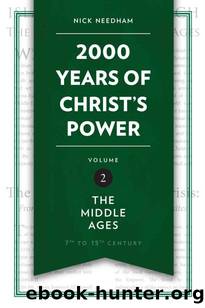2000 Years of Christ's Power Vol. 2: The Middle Ages by Nick R Needham

Author:Nick R Needham [Needham, Nick R]
Language: eng
Format: epub
Publisher: Christian Focus Publications
Published: 2016-10-25T17:00:00+00:00
At that point in the history of Mount Athos, there was no Serbian monastery, so Sava joined a Greek one. In fact, Savaâs first great contribution to Serbian Orthodoxy was to establish a monastic community for Serbs on Athos. This came about when his father, King Stephen, now aged 82, resigned from the Serbian throne in 1196 so that he could end his days as a monk, taking the name Simeon. Simeon joined Sava on Athos (the ex-king was no longer angry with his son for preferring monastic to court life); after an emotional reunion, father and son set about rebuilding the ruined Greek monastery of Hilander8 for use by their fellow Serbs. Their influence at the Byzantine court in Constantinople prompted Emperor Alexius III (1195-1203) to issue a decree granting Hilander to the Serbian people in 1199, as an independent, self-governing monastery. From that day onward, Hilander became a vital, thriving centre of Serb religion and culture, attracting multitudes of young Serbian men to Mount Athos and the monastic life. Having founded Hilander, Sava then built a private cell for himself and became a hermit, enriching his solitude by writing many hymns, prayers, treatises, and a biography of his father who died in 1200.
Meanwhile, Serbia had toppled into a bloody civil war between Simeonâs second son, King Stephen II (1196-1228), and Simeonâs other son Vukan. Stephen controlled the northern and eastern region of Serbia, Vukan the southern and western part. Here the struggle between Catholicism and Orthodoxy reared its head, for Vukan received the backing of pope Innocent III (1198-1216), the most politically powerful figure ever to occupy the episcopal throne of Rome;9 in return for Innocentâs support, Vukan placed the Serbian Church in his domain under papal authority. The war between Stephen and Vukan thus took on the colours of a religious conflict between Orthodox and Catholic. Things began to look distinctly bad for the Orthodox when a Catholic Crusader army overthrew the Byzantine Empire in 1204, capturing Constantinople and setting up a new French Catholic kingdom.10 Byzantium itself, the spiritual mother of Serbian Orthodoxy, lay prostrate beneath the swords of Catholic conquerors. The new French lords of the East even placed Mount Athos under the control of a Catholic bishop in 1205.
In the midst of these hammer-blow disasters for Orthodoxy, King Stephen pleaded with his brother, Sava, to return to devastated Serbia and help him heal the wounds of the nation. Sava finally agreed and arrived back in Serbia in 1207. He brought with him the coffin bearing the body of Simeon, the father of Sava, Stephen and Vukan. When the coffin was opened, Simeonâs body was still fresh (âincorruptâ), despite having been dead for seven years, and exuded a sweet-smelling oil and myrrh. This, in the Middle Ages, was the accepted sign that a dead believer was a true saint, and that his soul was now glorified in heaven; it is the origin of our phrase âthe odour of sanctityâ.11 So Serbs hailed Simeon as a saint (âSimeon the Myrrh-gusherâ).
Download
This site does not store any files on its server. We only index and link to content provided by other sites. Please contact the content providers to delete copyright contents if any and email us, we'll remove relevant links or contents immediately.
Signature in the Cell: DNA and the Evidence for Intelligent Design by Stephen C. Meyer(2879)
Real Sex by Lauren F. Winner(2869)
The Holy Spirit by Billy Graham(2779)
The Secret Power of Speaking God's Word by Joyce Meyer(2755)
The Gnostic Gospels by Pagels Elaine(2400)
Jesus by Paul Johnson(2230)
Devil, The by Almond Philip C(2207)
23:27 by H. L. Roberts(2144)
The Nativity by Geza Vermes(2117)
Chosen by God by R. C. Sproul(2057)
All Things New by John Eldredge(2052)
Angels of God: The Bible, the Church and the Heavenly Hosts by Mike Aquilina(1870)
Angels by Billy Graham(1844)
The Return of the Gods by Erich von Daniken(1842)
Knowing God by J.I. Packer(1724)
Jesus of Nazareth by Joseph Ratzinger(1709)
Evidence of the Afterlife by Jeffrey Long(1705)
The Gnostic Gospel of St. Thomas by Tau Malachi(1681)
How To Be Born Again by Billy Graham(1670)
